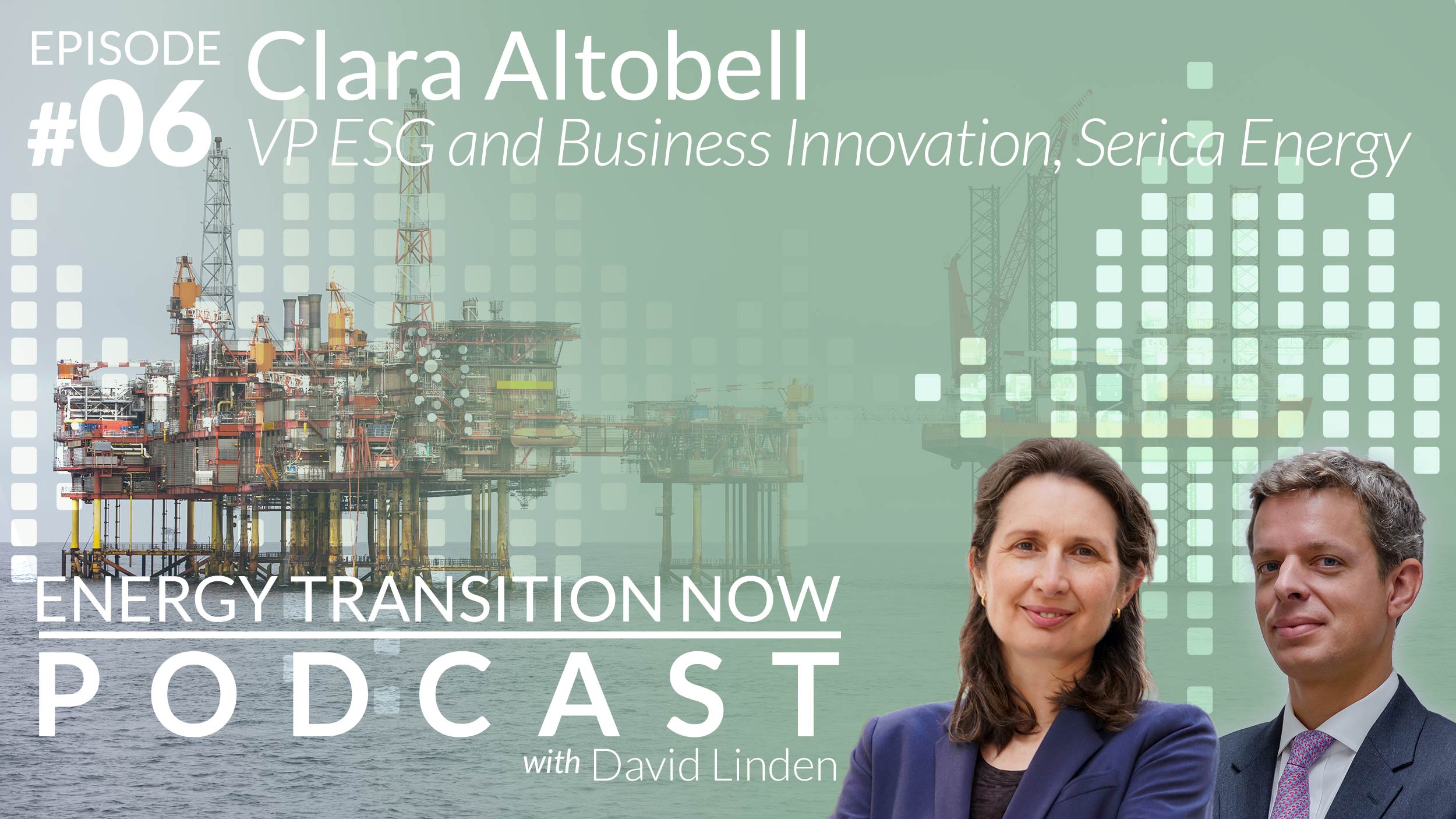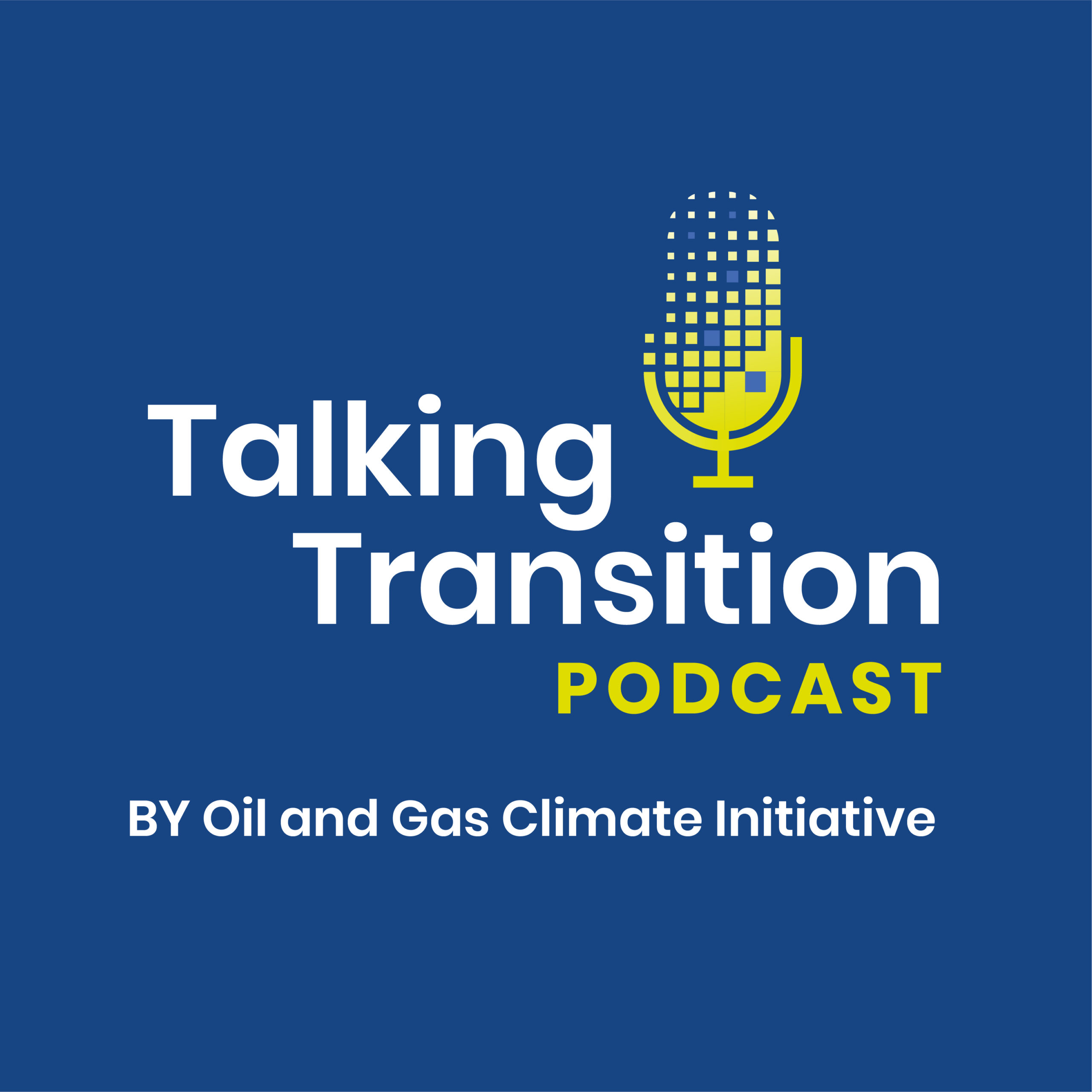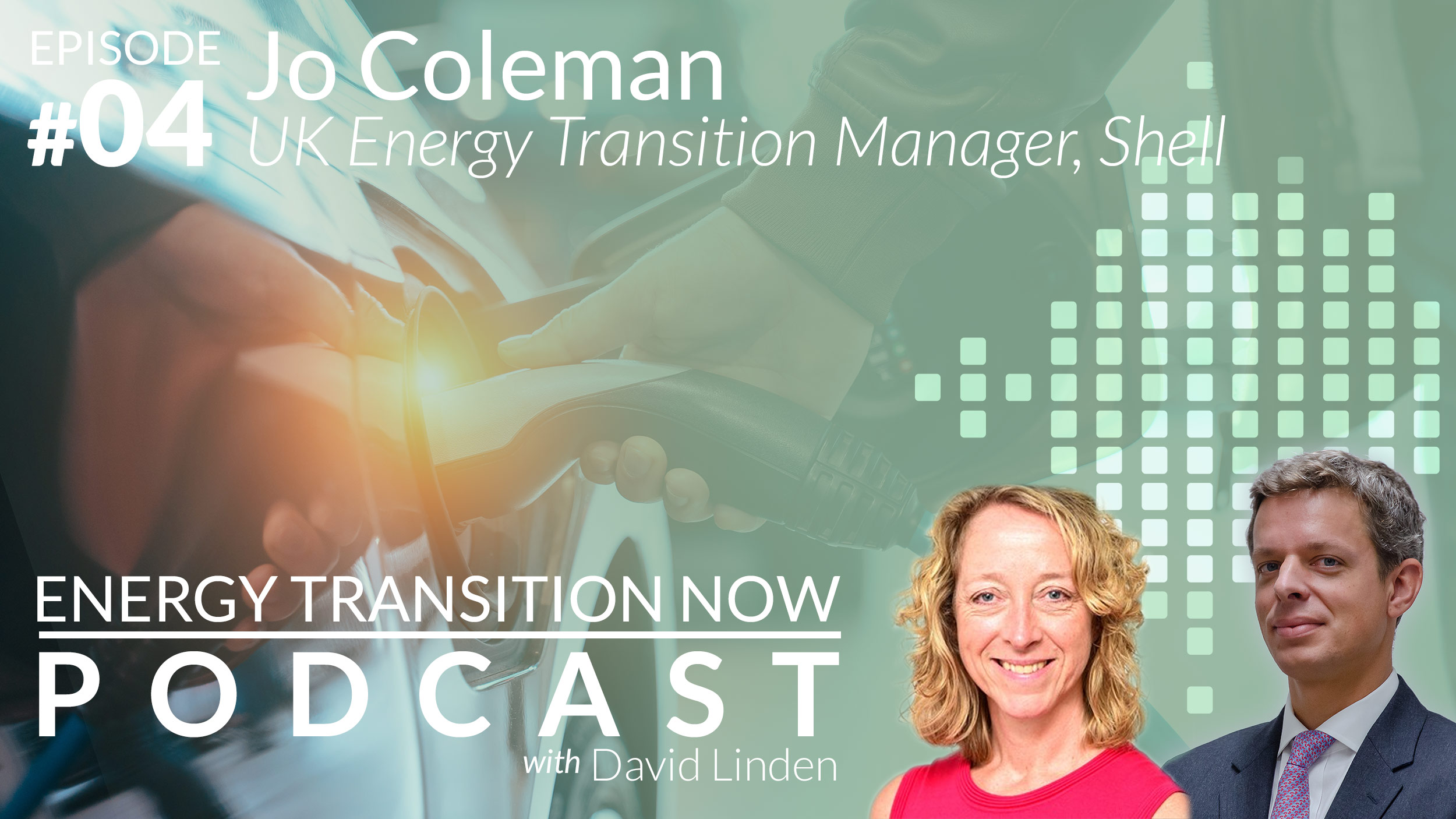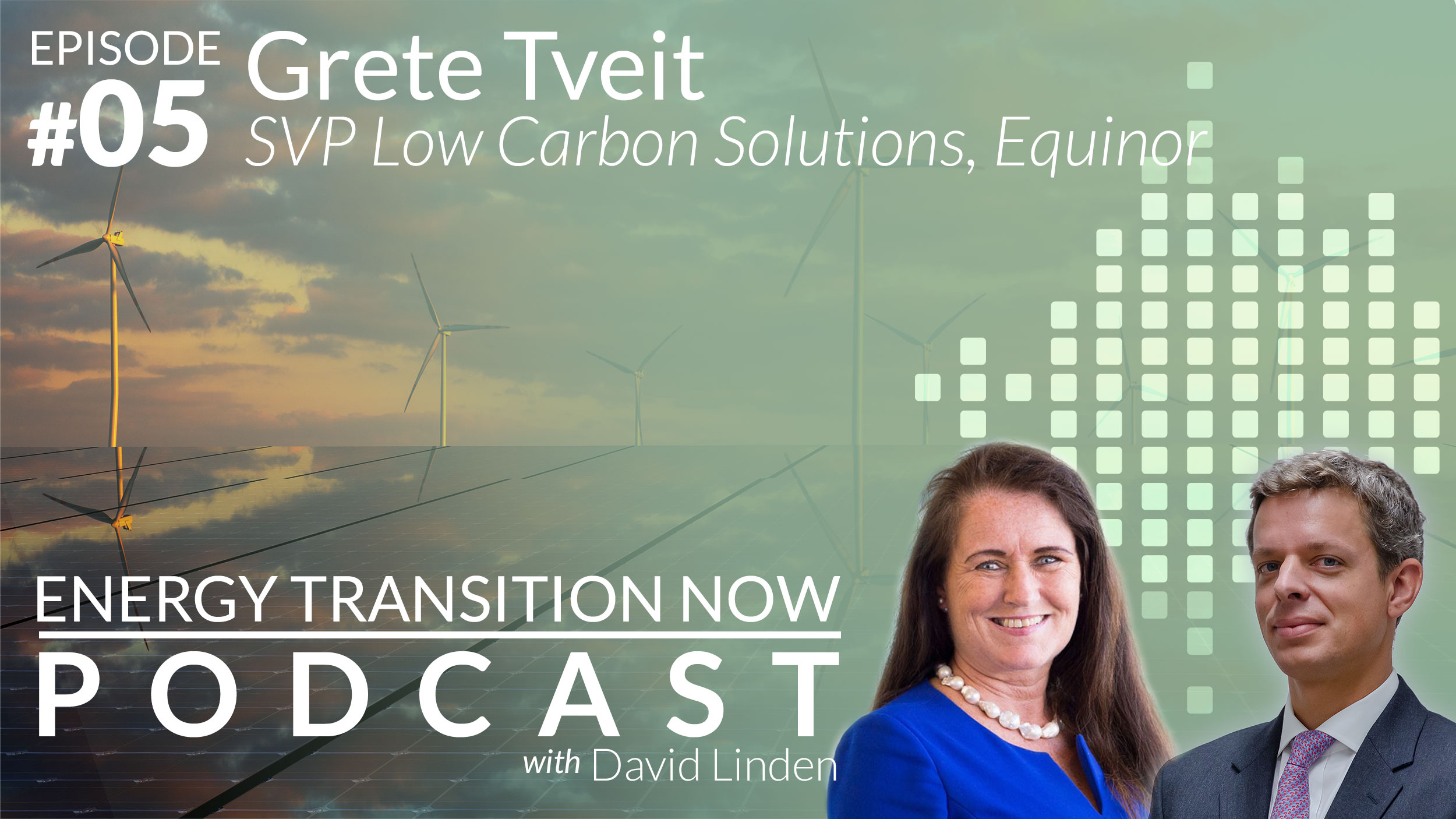Energy Transition Now - Episode 3 with Julien Perez
In the third episode of Westwood’s Energy Transition Now podcasts, David Linden speaks with Julien Perez, VP Strategy & Policy from the Oil and Gas Climate Initiative (OGCI).
In this episode, Julien addresses the risk of not including the oil and gas industry in the energy transition. The discussion covers a wide range of topics that the industry need to consider, including what it means to be Paris aligned, the range of options it has, as well as what the most efficient and cost-effective ways are to achieve carbon reduction (removal and mitigation). Julien also speaks about the practical actions that OGCI and its members are taking, including the targets, collaboration initiatives, and investments it is making.
About Julien

As Strategy & Policy Vice President of OGCI, Julien Perez is responsible for coordinating actions and commitments, developing external policy views, managing relations with institutions and external stakeholders, and providing strategic direction to drive future development of the organisation.
Previously, Julien was head of Climate & Energy Services at Ernst & Young where he assisted private and public players in setting up and implementing low-carbon strategies. Julien also worked at Total where he coordinated climate change actions and at Aecom managing environmental liabilities for various industries. Julien holds an Environmental Engineering degree from Agro ParisTech, an Energy and Climate Economics degree from Dauphine and an advanced degree in climate change management from Yale.
More from the OGCI
It’s easy to take a black and white view on the energy transition – but it doesn’t get the job done. Welcome to Talking Transitions, produced by the Oil and Gas Climate Initiative, or OGCI.
OGCI is composed of 12 of the biggest energy producers from around the world. If you want to know what we are really doing and thinking, listen in or download the Talking Transition podcasts on Spotify, Google or Apple or on our website – ogci.com
DL: Hello, everyone. I’m your host, David Linden, Head of Energy Transition at Westwood Global Energy Group, and you’re listening to our series of Energy Transition Now podcasts, where we discuss what the energy transition really means for the oil and gas, and broader energy industry.
So far, we have explored the fundamentals of the energy transition and the impact on our economies, the energy industry and oil and gas industry. In our last podcast, the IOGP gave us a sense of how the oil and gas industry is responding to the energy transition and the continued role it has to play going forward. Make sure you go back and listen to those first. But today you’ll hear from Julien Perez, who is the Vice President of Strategy and Policy for the Oil and Gas Climate Initiative, OGCI who present themselves as leading the industry response to climate change.
Julien’s role involves coordinating the OGCI’s actions and commitments, developing external policy views, managing relations with institutions and external stakeholders, and providing strategic direction to drive future development of the organisation. Prior to OGCI, Julien was the head of Climate and Energy Services at Ernst & Young. He also worked at a Total, and at Aecom. Julien holds an environmental engineering degree from Agro ParisTech and an energy and climate economics degree from Dauphine, and advanced degree in climate change management from Yale. So, he certainly knows this stuff. Julien, it’s truly excellent to have you with us. Thank you and welcome.
JP: Thanks a lot, David, for welcoming me. It’s a pleasure for me.
DL: So, as I said in my intro, I spoke with the IOGP last time around and they were obviously very positive on the contribution of oil and gas, to and in the energy transition. So, let’s start, I guess, with the obvious question. Should the oil and gas industry have a role to play in the energy transition?
JP: Well, the oil and gas industry is directly responsible for roughly four gigatons of CO2 equivalent per year. So that’s approximately eight percent of global greenhouse gas emission. And according to the IEA, accounting for the emission from combustion of the oil and gas products increase this figure to 20. So, 42 percent of the global greenhouse gas emission. So, I think that it would be fool to think that you can address climate change without talking about energy transition and about the role of the oil and gas has to play in this energy transition. So, if we want to be successful at solving the transition, we need to have this industry on the table. Energy plays today with every single segment of the economy. It’s not only turning the lights on or driving a car, it’s also producing any goods, any materials, shipping them, delivering them, refrigerating food, allowing access to education. I mean, the energy is really part of every single segment of the economy, considering the footprint of the oil and gas in the global economy and in the energy system. For me, that’s critical that we have to, to have them around the table. And if I may add something, transforming our relationship with energy means, again, as I mentioned earlier, transforming every single aspect of our way of living. Countries are managing energy as an essential resource. And you have at least one type of energy profile per country. So, the energy, the oil and gas industry brings decades, of years of experience in the energy markets with very deep understanding of the technical aspects of its capacity to run long term project with high degree of complexity in terms of interaction with other economic sector, international footprint, et cetera. So, believing that the transition will be made only by new entrants is to me, a risky idea, if not a fool idea. So, let’s benefit from the existing oil and gas company, which are transforming themselves to energy companies, to look to most of them, to have a long term experience, presence, capacity to make it happen much more quickly. And the role of the industry is simple. It’s to be net zero as soon as possible. So, both by working on its own emission and by supporting other sectors in industry, whilst at the same time, of course, continue to deliver the energy needs of the world.
DL: Thank you. We can touch on maybe the difference between the four gigatons and the wider gigatons, I think a little bit later, because there’s obviously an order of magnitude difference there and who has maybe ownership of some of that. But let’s get back to a little bit around sort of you who you’re representing here, because you’re speaking there, I guess, on the basis of the oil and gas industry as a whole. But OGCI does represent in theory a selection of companies. Can you maybe just talk about what actually OGCI is, what it represents, and you’ve got quite a diverse membership and how does that actually work?
JP: Yes, absolutely. So OGCI is a CEO led initiative, a pretty young organisation, and we’ve been kickstarted at the UN Climate Summit in 2014. And the idea was to bring together international oil companies. So, the Shell, the BP, ENI, Total and others, as well as NOCs and potentially more importantly, entities such as Saudi Aramco, Petrobras and CNPC and those 12 companies together, the 12 members of OGCI, account approximately for 30 percent of the oil and gas production. So those companies are joining forces basically to accelerate the development of a solution to a low carbon future. But we engage, of course, with the rest of the industry, we are not a private club, just isolated because of the nature of the energy system and the nature of the business, which requires a lot of joint venture and a lot of collaboration. We do join forces with others, players of the oil and gas industry, but also with the rest of the value chain. That’s absolutely critical for the solution to happen. So again, OGCI aims to be additional. That’s a very key component for us, we don’t want to repeat what the market is already offering, we don’t want to step on toes of other initiatives going on, we don’t want to repeat what our member companies are doing. The idea is really to be as additional as possible when it comes to what is the role a coalition of players can play like us. So, we mainly focus our action area on how to scale up solution. So, for instance, the methane emission, the carbon capture and storage, on the transport we mainly look at the marine or the aviation or the heavy-duty vehicle, all those segments of the transition that are, from our perspective, not sufficiently tackled, but have a very important potential.
DL: Interesting. Thank you. And I mean for clarity, maybe for the listener. You’re talking about things that need scaling up, but that doesn’t include maybe more nascent renewable energy technology. So, it doesn’t include maybe new forms of solar or those types of things.
JP: So, in the renewable energy space, most of our member companies are extremely active. So, this is, well it’s not becoming actually it’s already a very competitive market, as you know. So, we’re also binded by these boundaries for, as a coalition what we can do together without entering into this competitive space. So clearly the, on this this aspect, all member companies are extremely active. So, we don’t have a renewable energy as part of the OGCI agenda, not because we don’t believe renewable will be part of the solution. It’s quite obvious, but it’s probably because we believe too much that renewable is going to be part of the solution, and that’s why our member companies are so active. To give you an order of magnitude. They invest collectively, I think something around seven billion US dollar a year in low carbon solutions with a major share of it being on the renewable energy space. So, it’s quite a significant amount of money, and this number is just growing on a year by year.
DL: But we will come back to some of those of other investments and things that you’re doing in just a minute, but certainly good to dive into that. But as a principle then as a as an organisation, as you say, you were set up during Paris or the Paris Agreement to represent, I guess, as you say, and lead the way on the oil and gas industry, to climate action on that. And you say that your Paris aligned, and that’s obviously something that’s been used by a number of different companies and organisations. And if I were to reference maybe some of the NGOs out there who critique this, you know, the carbon trackers of the world, the transition pathway initiative, those guys who say, OK, well, here’s what we think Paris aligned is and we measure you against this and that, and it doesn’t make sense to the world. But the question really is, what is Paris aligned in that sense for the industry and for oil and gas? Because it’s important, I think, to be clear on what that means. So, you know what you’re targeting.
JP: Yes, absolutely. That’s a that’s a very good question. So, as you said, like what you say was set up more than a year in advance of the Paris agreements. And at that time, I mean, you may recall that the Paris agreement went through a very bumpy road. But we tried to participate and to collaborate to make this happen at our scale, of course, without being, staying modest of course, in what we could do. But maybe one thing that we have to do, to say, is to go back to the basics of what the Paris agreement is, and the Paris agreement has two main articles that we refer to when we say that we are Paris aligned. One is that we have to hold the increase of the global average temperature to well below two degrees and pursue any effort to limit it below one point five. And the other aspect is to achieve a balance between anthropogenic emission by sources and removals, by sources in renewables, by sinks of greenhouse gases in the second half of the century. So that’s what the Paris agreement says. The Paris agreement is an agreement between countries. So, there’s no private players signing up to the Paris agreement. But what we do as an industry group such as OGCI, such as our individual member companies, is that we support the aims of the achievement of the Paris agreement. Again, within our parameter, within our area of influence. The Global Net Zero is already included in the Paris agreement, and the OGCI supports it. Eight of our member companies already also set their own net zero ambition on their own perimeter in the last two years. So, what OGCI is doing and when we say that we are Paris aligned is that we try to support the achievement of the goals of the Paris agreement because this is our role as private players. And to do that, again, as I mentioned earlier, we have two main things. One is to play a catalyst role, so trying to incentivise our member companies to accelerate their evolution toward a low carbon future. And the second aspect is what we can do as a coalition, as a group, to join forces, to develop short term, practical, tangible mitigation action for it, for all member companies, but also for the rest of the industry.
DL: Maybe a bit more of a controversial question then. Do you do say that this year the Paris agreement is done between countries, but ultimately, if countries are deciding the direction of where we’re going, and I think about 60 percent of GDP is basically decided to be net zero by mid-century by now. Should it not be natural that anyone who’s Paris aligned, should be net zero aligned in that sense?
JP: Well, yes. I mean, to some extent you have to consider what the what the policymakers are enabling you to do, and what is the environment they are placing you and what type of efforts they are willing to consider for the population. Because this is this is what it is. I mean, the energy as we discussed just before, the energy system is really in every single segment of the economy. So, it’s not neutral for a country to say that they aim to be net zero, that requires a massive transformation in every infrastructure, in the way of living, in carbon pricing mechanism, stuff like that. So, I think there is this jurisdictional aspect of it and how the member companies can contribute and can accelerate this transformation. We have a lot of partnership, for instance, with the United Nation or with the World Bank to accelerate commitment from some countries on the climate agenda. So, we do contribute also from that perspective. Does a company, a global company, have to define a net zero target? I think it’s, it’s what it is, I mean, the world is moving toward that. So clearly, that’s an aspect that we’re trying to incentivise and push the rest of the industry to really look in that direction. Then it’s what do you count in your net zero, which is the critical aspect, because the own emission of the oil and gas industry, as we mentioned, is four gigatons, so on that they have control, they have you know, they can play a role, a direct role, but the rest is the scope three, and the scope three is something that is a shared in responsibility between who is delivering the product to the market and who is buying it, and driving the demand and consuming and burn it, and this is outside of the control of the companies. So, it’s something that has to come as a joint effort, I would say.
DL: And then when we look at, you talk about taking action, collaborating, et cetera. Can you maybe just give me some examples of what OGCI itself or the OGCI climate investments is doing to support the transition of the industry?
JP: Yes, absolutely. So, I’m going to just drop some example here, but I’m very happy to dig into further if you want to. One aspect is that we do, is that we try to define targets for member companies because we do believe that having an endpoint then drives down the strategy to achieve these targets. So, we talk about global net zero ambition, but we want to also as OGCI, as you just mentioned, to be practical, tangible, short term. And so, we don’t necessarily look only at the mid-century or the second half of the century time period, but also something much more short time action. And so, for instance, we defined with our member companies a methane intensity and a carbon intensity ambition that was released in the last few years. And both of them have a target here in 2025. So, it aims to be again, near term and very practical. And the idea for us is for those targets, to be meaningful, to be benchmarked against and align with a scenario that is a compliant with the Paris agreement goal. So, for instance, the sustainable development scenario of the of the IEA, and the idea is also to set some form of, let’s say, a benchmark point for the rest of the industry. So, our member companies are all aligned behind this, the joint aggregated targets that we have defined. But it also sends a signal to the rest of the market that, yes, you can achieve such a low level of intensity, and let’s work together to see how the rest of the industry could align on that or even go one step further. That would be fantastic. So, it would be a positive competition, if I may. So, for instance, to give you an order of magnitude to those two targets together represent roughly, I would say, between 35 and 50 million tonnes of CO2 per year of production. And this will be going to happen starting from 2025. We are already seeing some savings today, but in the next four years, we’re going to reach that. So, it’s a meaningful contribution, I think, when you put that in the scale of other announcements that are made by other type of industry. So that’s for our member companies. But if you look at outside of OGCI member company’s perimeter, we also see, a key action, which is to foster the development of CCUS hubs on the ground, to support the decarbonisation of multiple sector industries. I mean, you know, that some industry will be, it’s going to be very challenging for them to reduce their scop one and two emissions, just because it’s process emissions, not something that is linked with the consumption of fossil fuel, but it’s just because, like the cement industry, they produce CO2 because of the process, like it’s a chemical reaction that produces CO2. So here the oil and gas industry for the CCUS part, it brings a unique combination of skill sets to enable CCUS, again, as I mentioned, including the capacity to mobilise engineering resources, manage very complex projects. Of course, the subsurface knowledge, which is essential, as you can imagine, for carbon capture and storage, and as a coalition of oil and gas companies, we also go beyond our individual member company’s efforts to identify the value creation of CCUS per country, to support the science of emerging CCUS technology and engage policymakers, to support an efficient regulatory environment, and also identify the hubs where those projects can be profitable. So that makes sense for other players as well to join their emission altogether and build up a project that could neutralise those CO2 emission. So, we have launched, for instance, the CCUS kickstarter initiative in that perspective to identify those hubs, and we are also directly involved in hub’s development. So, it’s not only like just sharing good ideas, but it’s we also apply ourself. Other example maybe that I could share with you is on the transport sector, where we do believe also that there’s space for a coalition like us to enable solutions to happen. So, it could be, for instance, on the marine transport or the aviation transport where we engage as well with the rest of the value chain to identify pilot project that would, that could be useful for the world to know that the technology can work and it could be scaled up, et cetera, et cetera. And as you say, OGCI is equipped by an investment fund, OGCI climate investment, which is a one billion plus US dollar fund, that is, the shareholder are the member companies, and the idea of the OGCICI is to, so OGCI climate investments, it’s the acronym that we use, is to catalyse the low carbon ecosystem and deliver a carbon reduction. So, the fund works to achieve this objective by investing in technologies and projects which can demonstrate a reduction in methane or carbon dioxide emission, collaborating with the OGCI members and partners to accelerate the time to market for the innovator through pilots and global implementation projects, and co investing with a global fund to drive more capital into decarbonisation. So today, for instance, we have 21 investments in the portfolio, and many have reached a significant milestone in the past year, so the Climate Investment Fund continues to seek out more investments that can help deliver impact. And so far, this year, the fund has made two new investments, one in Andium, which is a company, an Internet of Things company, helping to detect methane and Next Decade, which is a CCUS for LNG projects. So, it’s a very active branch of OGCI.
DL: Very interesting. Certainly, just listening to you there, you know, you almost struggle to put all the examples forward because there is clearly a lot that you’re doing. And it’s good to hear that, obviously you’re aligning it to Paris and you’re working, collaborating across different industries, which is core to be able to deal with the question we have of climate. Now, if I was to turn that slightly around, though, and I listened back to maybe our first podcast that we had with Will Day, who, looking at it as an outsider, would sort of sit here and go, and obviously I don’t want to put words in his mouth, but maybe look at this and go, OK, well, are you maybe not by, for example, addressing the methane side of things, simply trying to do a bad thing better, is just quoting him on that one. Yes, it’s important. It’s necessary. Very clear. I mean, methane obviously causes significant short-term damage to our climate. But is doing a bad thing better, a good idea here. And that’s sort of part one. And part two is, is investing in things like CCS. Again, this is that unnecessarily prolonging hydrocarbons and therefore putting the energy transition at risk? Yes, there may be some niche applications, but longer term, I guess the goal is to not need those in the first place.
JP: Yes, that’s a challenging question. I would say maybe just to echo what you said. I don’t know if, it’s addressing methane is doing a good thing for a bad thing, and so is the good solution. What I know today is that the world relies on oil and gas, and I don’t see like a switch overnight to happen, it is going to take time. And so, and as you say, methane has a short lifetime, but a high global warming potential. And so, sorting out the flux of methane going into the atmosphere can reduce the stock that is in the atmosphere relatively quickly because it can be eliminated by a chemical reaction in the atmosphere. So, and the methane is responsible roughly a quarter of the global warming that we are experiencing today. So, it’s a quick win, clearly, that we can do to try to start sorting out the climate change challenge. So, so clearly, I think this is a focus area for us, because as long as there will be oil and gas production, there will be a methane issue to challenge. And so, we have to tackle it. The other was referred to your other question. I don’t have a crystal ball to know what the energy mix, demand and supply of tomorrow will look like. I know that there is a trend and the tendency going to other much lower carbon future, which is great, but you never know when it’s going to happen and what can hit us, such as a Covid or whatever, that could slow us down. So, when you think of the energy issue, we have to think all of the above strategy that’s needed in order to kerb the greenhouse gas emission and meet the net zero by 2050. So, for me, it’s not necessarily that CCUS is going to delay the transformation. It’s CCUS or renewable or energy efficiencies altogether. And it’s altogether because it has to follow the basic market rule, which is a merit order, how you’re going to pay to reduce the tons of CO2 emission, which is your marginal cost of abatement. That’s what has to be considered. And this is a country-by-country analysis or even a region by region analysis, it’s not something that is, there is no one silver bullet that can solve this issue. This is a very complex issue, and we have few weapons at our disposition, let’s use all of them because the battle is going to be very difficult to win. So, if you follow this merit order, depending on the countries, the CCUS may come in the middle range of solutions, why not use it? I mean, that would be a stupid idea for me, because it’s going to cost more for the society. It’s going to take more time than deploying of a solution. And actually, when you look at just the IPCC scenarios, like I don’t think that there is any more IPCC scenario that are not referring to massive use of CCUS, and actually as the time fly and as the greenhouse gas emission of the world continue to grow, the CCUS and the solution to capture and store those emissions, as well as [00:25:22]the net negative emission that are allowed by CCUS, like direct air capture or bio energy CCS, [5.4s] those will be more and more necessary. And even if you take the report that was released yesterday by the IEA, the CCUS has a very predominant role, even if less than what the IPCC is claiming for, it’s still like a massive increase that has to happen. And maybe one last point. When you think about this CCUS, the project development phase is relatively long because, again, those project are, extremely complex, you have to make drillings to have a good understanding of the information that you would inject the CO2 in, et cetera. So, between the idea of, you have identified a hub in one place in the world where potentially there could be an interest to develop a hub and a time for the first tons of CO2 to be stored. You have approximately ten years. Ten years, you are already in 2030. If you, if we were to identify the project today, and we are talking about 2050, so only 20 years after that. So, the time period here is going to be critical. And again, as I make this metaphor just before, we have like multiple solution in hands, it would be stupid for me, if we were just considering that one has to be put aside just because of philosophical consideration.
DL: Very interesting indeed. Yes. It’s certainly the base in every scenario you see out there now has a slightly different version of CCS, nature-based solutions, et cetera in there and there’s a lot of uncertainty. But as you say, it’s part of the pace of the change that’s needed because some of these things simply take time. And I think just for clarity for the listener, as Julien is responding to the fact that the IEA, for example, put out its report yesterday. But, of course, we were recording the day after, so when you’re listening to this, it’ll be a week or so afterwards. I’m sure there’ll be much more debate on that afterwards. But let’s just briefly come back to the investment, the investment time frame and what’s needed to make things work in, with the pace of change that we really need to have for this to work. A key question often comes up around carbon pricing and the role of carbon pricing to be able to achieve that. Now, I know several of your member companies do support carbon pricing, but it’s never happened, really. I mean, very limited at least there’s the EU ETS and now China’s started its own one, but otherwise it’s maybe a quarter of the world or so that’s covered by a carbon price. Can you maybe talk us through what’s your position on this in terms of carbon pricing and also talk about why it’s important, maybe even relative to other mechanisms that are available?
JP: Yes, absolutely. So, yeah, I have I have a rough same figure as you like 22 percent of global greenhouse gas emissions are covered today by a carbon pricing system, according to the World Bank. So clearly, I mean, for us, for OGCI the most effective means of reducing emissions is the application of an economic value or price to carbon based emission, because this is sending the signal to the markets that you have to switch, and also to the consumer because you have a pass through mechanism, of course, when you have a carbon tax, for instance, it is applied to a producer, this is going to be reflected in the price of the goods that will be sold to the consumer, so the consumer will have, you know, basic debate saying I have a cheap product and an expensive product. I mean, naturally, you’re going to take up the cheap product for the same quality. So that’s the signal that you have to send to the market and to involve, to some extent, the consumer at the end of the value chain to take the right decision. So OGCI today supports explicit market-based mechanisms, such a carbon tax or emission trading programmes. And in case it’s not possible or not practicable, and in some countries, that could be the case. Developing countries, for instance, where you don’t have the governance system at the government level to allow to implement such a system that is relatively complex from a fiscal standpoint, you could you could also imagine other implicit carbon valuation mechanisms, such as getting cost conscious performance standards or financial incentives, such as tax credits or subsidies for emerging technologies, providing again that they are transparence, well designed, well defined, does not distort competition, and are part of a holistic policy framework that aims to achieve the desired climate ambition. And those are not mutually exclusive, like there is a number of jurisdictions I have in mind that are combining ETS, like even in Europe, for instance, where you have ETS, some countries are applying carbon taxes on specific products, also putting incentives for renewables or for energy efficiency measures, etc. So, all of that can be combined into a system that is coherent to some extent. So why are carbon value, or what carbon values I should say, because I don’t believe personally that we’ll never end to one carbon pricing system across all the world. Those are again, you know, to be designed depending on the profile of emissions and the profile of the country and the capacity. Also, the willingness to pay for it by the consumer, but what carbon values are important governments in designing and implementing appropriate policy and regulation play, of course, an important role in reducing carbon emissions. And so, to be effective, again, such policy should really maximise the efficiency and minimise the economic distortion. We’ve seen in the past, a number of mechanisms that were put in place, but not designed in a way that were the most efficient that actually really, were not as efficient as it could have been. And of course, we are learning by doing – it is not a critique – but I think now we have sufficient history behind us to properly design an appropriate mechanism, again, depending on the profile of the country. And the most efficient policy and regulation of those that are the highest volume of emission, of the lowest social societal cost. And for the majority of sources and sectors, the most effective means, again, of reducing emissions is the application of an economic value, or price to carbon-based emission. Maybe one thing to also recall an aspect of your question. And, recalling to the previous one, I think one thing that was interesting for me is the parallel that we have with renewable. When I started my career in climate, roughly 20 years ago, PV panels were completely out of the market because too expensive, too complex, not sufficiently efficient. It looks like it was a solution that would never fly. And actually, when you think about the policy mechanisms that were put in place to support the renewable, it has been relatively efficient. There would be a waste of energy and money. But again, we are learning by doing. But now it’s very efficient. Renewable energy is competitive in many markets and this is a success story for me. And why not inspiring from that to enable other solutions to happen? And again, such as CCUS, such as hydrogen, such as direct air capture, such as battery-based solution, all of them come together into a system, that’s where carbon valuation or carbon pricing can help in achieving their full potential.
DL: OK, well, that’s a really interesting look at carbon pricing. Obviously has multiple uses and multiple opportunities there to move technologies and mechanisms forward to deal with the climate challenge. But what are your thoughts on now, as we get to net zero, companies are setting these targets and depending on what your view is on this, is using things like offsetting as the primary mechanism at times to deal with their emissions. What’s your thoughts on offsetting? Is this is this actually an acceptable tool to use to get to net zero?
JP: Yes, thanks, David. I think it’s an interesting question because it’s all about, again, the question of merit order. Does it cost for the society per tons of CO2, depending on the area where you are, your country profile, the potential side benefits as well on others. And here the NCS of course, has a critical advantage compared to other solution for me. So natural climate solution or NCS are critical components to address climate change and support the achievement of the Paris Agreement goals. And by NCS, I encompass not only forest, which is the usual suspect we are thinking of, but there is a number of other NCS areas such as restoration, grasslands, mangroves, agricultural soils, wetlands. All of that is part of the global greenhouse gas emission balance. And again, I think not playing with a portion of the equation to try to solve the problem would probably not lead us to the most efficient way to achieve a net zero future. So, for instance, if you take the restoration of forest, agriculture, or soil, it can, for example, increase forest and soil carbon stock, removing carbon from the atmosphere. The coastal wetland as well, of course, have a huge potential. And when you combine all of that, I mean, of course, on the NCS, the difficulty is that it’s not a technology per se, so assessing the potential is always more difficult than the rest. But a number of studies consider that the NCS has the potential to deliver through 2030, at least a third of the cost-effective CO2 mitigation needed for emission to be aligned with the goals of the Paris agreement. And this is part of the IPCC scenario, for instance, puts a lot of emphasis on the role NCS could play. But when I say that, then you have to consider what is a good NCS project. And this is absolutely critical, because you have forest and forest, if I may. so we have to ensure that the NCS is very good and the highest level of standard of social and environmental integrity, while also protecting resilience of communities to the impact of climate change. And they can provide, when well managed a range of other benefits for society, such as economic growth or diversification, improvement of human health and livelihoods, or protection of biodiversity and water resources in alignment with the UN SDGs. So that’s the beauty of the NCS is that it’s well managed, and it brings a lot of side benefits, if I may, other than climate. So OGCI is quite active, we are part of the Natural Climate Solution Alliance, for instance, and we support policies and national strategies and initiatives that aims to scale up the use of high quality NCS as a complementary decarbonisation tool. So, I’m not saying that we’re going to offset the 4 gigaton, or the 20 gigaton with NCS, it’s part of a merit order. But what is clear is that you start by mitigate or avoid, and then for the emissions that you cannot avoid at a reasonable cost or with existing technology, then you can use the offset in a meaningful manner that it brings sufficient side benefits to the society.
DL: So it’s not a question of, it’s your first or your last port of call. It’s just a question based on all the other options you have available to you now, where does it sit in the merit order and should you therefore use it as part of the process or not?
JP: Yes, absolutely. Clearly, our priority is given to mitigation because that’s part of the control that you have, and there is a lot of uncertainty as well, as with the offsets market. You could have, as we’ve seen, unfortunately, in Australia in the recent years, like major forest fire to just cancel all the effort that were made to collect this carbon emission. So, priority to mitigation, because this is tangible, this is practical, you can measure it. But of course, the NCS has to be part of the solution. Again, it’s like CCS for me, it’s part of the weapon that we have. I mean, why don’t we, we don’t have the time and the luxury to wait. So, let’s play with everything we have.
DL: I think with that last comment there, I think we’ll wrap up there. So, thank you for taking the time to actually walk us through, first of all, the role of OGCI, but also I think the wide range of questions and issues that both you and I guess broader, more broadly excuse me, society, but also the oil and gas communities trying to grapple with and deal with. And, you know, I think my key takeaway in that sense really is, trying to take advantage of all the different tools that you have, because there isn’t a huge amount of time for us to do this. So, let’s get on with it.
JP: Yes, absolutely. Absolutely. Thanks for inviting me. And it was a pleasure to discuss with you.
DL: Wonderful. Great to have you Julien. Thanks very much.
JP: Thank you.
Copyright and Reproduction
This website contains material which is owned by or licensed to Westwood Global Energy Group. This material includes, but is not limited to, the design, layout, look, appearance and graphics. You may not modify, reproduce or distribute the content, design or layout of the Website, or individual sections of the content, design or layout of the Website, without our express prior written permission. For media enquiries, please contact [email protected]
Sign-up to receive energy transition news and alerts of new podcast releases
Episodes coming soon!
EPISODE 6

Clara Altobell
VP ESG and Business Innovation, Serica Energy







